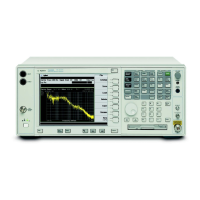Chapter 5 297
Programming Fundamentals
Improving Measurement Speed
Programming Fundamentals
Improving Measurement Speed
There are a number of things you can do in your programs to make
them run faster:
“Turn off the display updates.” on page 297
“Use binary data format instead of ASCII” on page 297
“Minimize the number of GPIB transactions.” on page 298
“Put ADC Ranging in Bypass for FFT Measurements” on page 299
“Minimize DUT/instrument setup changes.” on page 299
“Consider using LAN instead of GPIB.” on page 299
There are additional things you can do to run faster if you are using a
measurement personality option (i.e. instrument Modes other than the
standard Spectrum Analysis Mode). These considerations only apply to
specific option modes.
“Using an Option Mode: Minimize the number of GPIB
transactions.” on page 299
“Using an Option Mode: Avoid automatic attenuator setting.” on
page 300
“Using an Option Mode: Optimize your GSM output RF spectrum
switching measurement.” on page 301
“Using an Option Mode: Avoid using RFBurst trigger for single burst
signals.” on page 301
“Using an Option Mode: When making power measurements on
multiple bursts or slots, use CALCulate:DATA<n>:COMPress?” on
page 302
Turn off the display updates.
:DISPlay:ENABle OFF turns off the display. That is, the data may still
be visible, but it will no longer be updated. Updating the display slows
down the measurement. For remote testing, since the computer is
processing the data rather than a person, there is no need to display the
data on the analyzer screen.
Use binary data format instead of ASCII
The ASCII data format is the instrument default since it is easier for
people to understand and is required by SCPI for *RST. However, data
input/output is faster using the binary formats.
:FORMat:DATA REAL,64 selects the 64-bit binary data format for all

